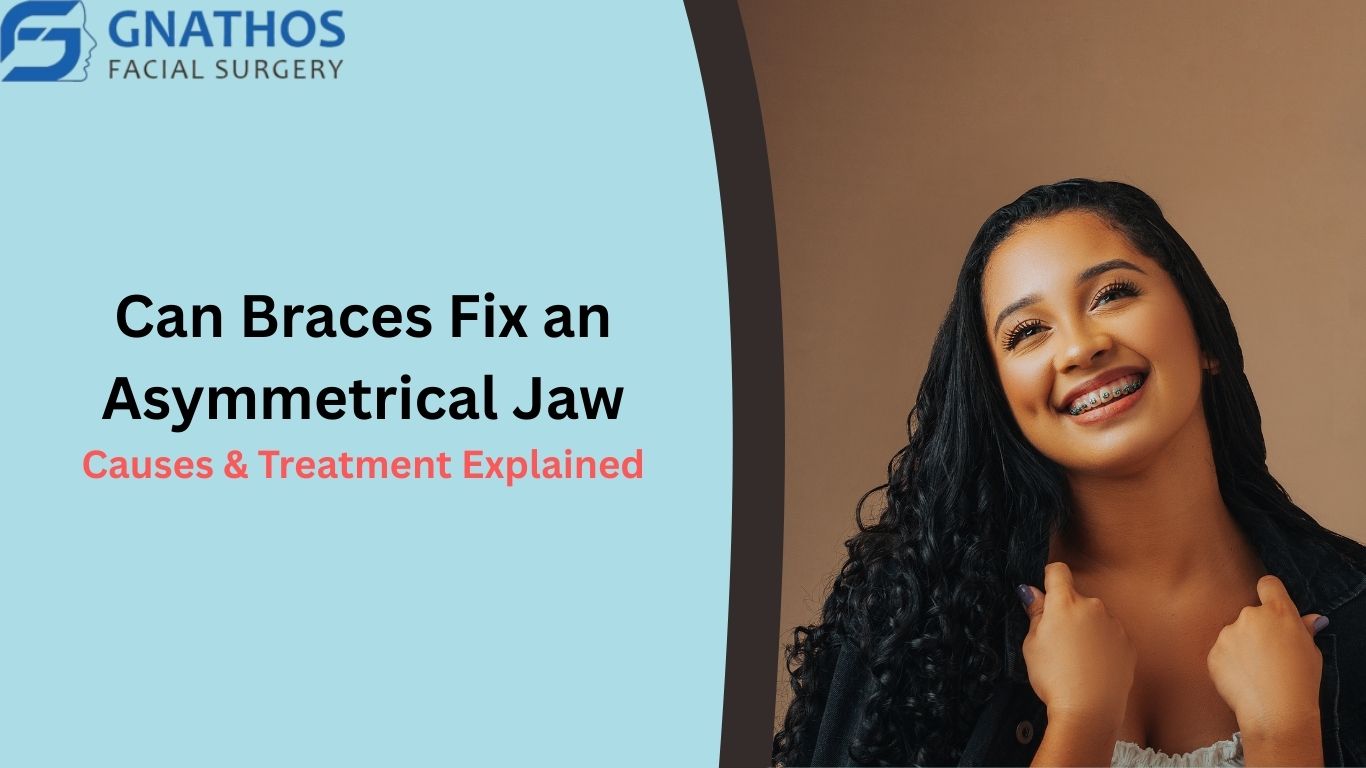You’ve probably looked in the mirror and noticed that your face isn’t perfectly symmetrical – and that’s normal! A slight difference between the left and right sides of our faces is part of what makes us unique. But what if that asymmetry is more pronounced, specifically in your jaw? Perhaps you’ve noticed that your chin appears off-center, one side of your jaw looks larger or smaller, or your teeth don’t quite line up. This can be more than just a cosmetic concern; it can affect your bite, your speech, and even your overall comfort.
If you’re dealing with this, a common question that pops into your mind might be: Can braces fix an asymmetrical jaw? It’s a fantastic question because braces are famously known for moving teeth and aligning bites. But when the problem lies with the jaw itself, things get a bit more complex. Today, we’re going to dive deep into the causes of jaw asymmetry, explore the various treatment options, and get a clear answer to whether can braces fix an asymmetrical jaw on their own. We’ll help you understand when braces are enough and when you might need to consider other paths to a more balanced and functional smile.
Understanding Jaw Asymmetry: More Than Just a Mirror Image
Jaw asymmetry refers to a noticeable difference in the size, shape, or position of the lower jaw (mandible) or upper jaw (maxilla) between the left and right sides of your face. This can manifest in various ways:
- Chin Deviation: The chin points significantly off to one side.
- Mandibular Shift: The entire lower jaw appears to be pushed or pulled to one side.
- Uneven Jawline: One side of the jaw looks bulkier or more developed than the other.
- Cant or Tilt: Your upper or lower teeth line might be tilted, appearing higher on one side than the other.
- Asymmetrical Smile: Your smile might look uneven or pulled to one side.
- Bite Problems (Malocclusion): Your upper and lower teeth may not meet correctly, leading to issues with chewing, speech, and excessive wear on certain teeth.
It’s important to distinguish between minor, normal facial asymmetry and a clinically significant jaw asymmetry that might require intervention. When the asymmetry affects function (like your bite) or causes significant aesthetic concerns, it’s worth exploring treatment options.
Worried About an Asymmetrical Jaw?
Braces and advanced orthodontic treatments can help correct jaw asymmetry, improve facial balance, and restore your confident smile.
Book Your ConsultationWhat Causes an Asymmetrical Jaw? Pinpointing the Root
The causes of an asymmetrical jaw are varied and can range from genetic factors to trauma or developmental issues. Understanding the cause is crucial because it directly influences whether can braces fix an asymmetrical jaw or if a different approach is needed.
- Developmental Factors (Most Common):
- Unilateral Condylar Hyperplasia/Hypoplasia: This is a key player. It refers to the overgrowth (hyperplasia) or underdevelopment (hypoplasia) of one of the condyles – the rounded ends of your jawbone that articulate with your skull at the TMJ. If one condyle grows too much or too little compared to the other side, it can lead to a significant jaw asymmetry, often causing the chin to deviate and the bite to be uneven. This usually becomes apparent during growth spurts in adolescence.
- Hemifacial Microsomia: A congenital condition where the tissues on one side of the face are underdeveloped, including bone (jaw, cheekbone, eye socket), soft tissues, nerves, and muscles. This can lead to severe jaw asymmetry from birth.
- Growth Disturbances: Other less specific growth disturbances during childhood or adolescence can result in uneven jaw development.
- Trauma/Injury:
- Fractures: A fracture to the jaw, especially to the condyle during childhood or adolescence, can disrupt normal growth on that side, potentially leading to asymmetry as the jaw develops. If not properly healed, it can also result in a physical deviation or misalignment.
- TMJ Injury: Damage to the temporomandibular joint (TMJ) itself from trauma can affect its function and growth patterns, contributing to asymmetry.
- Pathological Conditions:
- Tumors or Cysts: The presence of a benign (non-cancerous) or malignant (cancerous) growth within the jawbone or surrounding soft tissues can cause localized expansion, displacement, or destruction of bone, leading to visible asymmetry.
- Infections: Chronic infections in the jawbone (osteomyelitis) can affect bone remodeling and lead to deformities.
- Dental/Occlusal Factors:
- Crossbite: A specific type of malocclusion where some upper teeth bite inside the lower teeth. If this occurs on one side, it can cause the lower jaw to shift habitually to one side to achieve a more comfortable bite, creating a functional asymmetry that might appear structural over time.
- Missing Teeth: Long-term absence of teeth on one side can lead to changes in chewing patterns, bone loss, and gradual shifting of the jaw.
- Unbalanced Chewing Habits: Consistently favoring one side for chewing due to pain or preference can lead to muscle hypertrophy (overdevelopment) on that side, contributing to a subtle muscular asymmetry that might be perceived as jaw asymmetry.
- Neuromuscular Disorders:
- Conditions affecting facial nerves or muscles (e.g., stroke, Bell’s Palsy) can lead to muscle weakness or paralysis on one side, impacting jaw movement and potentially contributing to asymmetry over time, although this is more about muscle function than bone structure.
Worried About an Asymmetrical Jaw?
Braces and advanced orthodontic treatments can help correct jaw asymmetry, improve facial balance, and restore your confident smile.
Book Your ConsultationThe Big Question: Can Braces Fix an Asymmetrical Jaw?
This is where understanding the cause truly matters. The simple answer to can braces fix an asymmetrical jaw is: It depends on the underlying cause and the severity of the asymmetry.
- When Braces Can Help (Often with Adjunctive Treatment):
- Dental Compensation for Mild Skeletal Asymmetry: If the jaw asymmetry is very mild and the primary problem is how the teeth are compensating for it (e.g., teeth tilting to hide a slight jaw discrepancy), braces can sometimes re-align the teeth to improve the bite and facial balance. However, the underlying bone asymmetry remains.
- Functional Asymmetry due to Crossbite: If the jaw asymmetry is primarily functional – meaning the jaw shifts to one side to achieve a comfortable bite due to a dental crossbite – braces (or other orthodontic appliances like palatal expanders) can correct the crossbite, allowing the jaw to assume a more centered and symmetrical resting position. In these cases, the skeletal structure isn’t asymmetrical, but the way the jaw closes makes it appear so. Can braces fix an asymmetrical jaw like this? Yes, often effectively.
- Pre-Surgical Orthodontics: This is where braces play a crucial, but not solitary, role. For significant skeletal (bone-related) jaw asymmetry, braces are almost always used before and after jaw surgery (orthognathic surgery). In this scenario, braces align the teeth within each jaw so that when the surgeon repositions the jaw bones, the teeth fit together perfectly. So, while braces don’t move the jawbones themselves, they are indispensable in the overall process of correcting skeletal asymmetry.
- Dental Compensation for Mild Skeletal Asymmetry: If the jaw asymmetry is very mild and the primary problem is how the teeth are compensating for it (e.g., teeth tilting to hide a slight jaw discrepancy), braces can sometimes re-align the teeth to improve the bite and facial balance. However, the underlying bone asymmetry remains.
- When Braces Cannot Fix an Asymmetrical Jaw on Their Own:
- Significant Skeletal Asymmetry: If the asymmetry is due to a true difference in the size, shape, or position of the jawbones themselves (e.g., due to condylar hyperplasia, hypoplasia, or significant developmental differences), braces alone cannot correct the underlying bone discrepancy. Braces move teeth within bone; they do not move the bones themselves. In these cases, the answer to can braces fix an asymmetrical jaw is a resounding “no” on their own. This requires a surgical approach.
- Asymmetry due to Tumors or Trauma: If the asymmetry is caused by a tumor, cyst, or unhealed fracture that has permanently altered the bone structure, braces cannot address the root cause. These conditions require specific medical or surgical intervention first.
- Significant Skeletal Asymmetry: If the asymmetry is due to a true difference in the size, shape, or position of the jawbones themselves (e.g., due to condylar hyperplasia, hypoplasia, or significant developmental differences), braces alone cannot correct the underlying bone discrepancy. Braces move teeth within bone; they do not move the bones themselves. In these cases, the answer to can braces fix an asymmetrical jaw is a resounding “no” on their own. This requires a surgical approach.
Worried About an Asymmetrical Jaw?
Braces and advanced orthodontic treatments can help correct jaw asymmetry, improve facial balance, and restore your confident smile.
Book Your ConsultationThe Diagnostic Journey: Pinpointing the Problem
Because the answer to can braces fix an asymmetrical jaw depends entirely on the cause, an accurate and thorough diagnosis is paramount. This isn’t something you can figure out by just looking in the mirror.
- Initial Consultation (Dentist/Orthodontist):
- Your general dentist might be the first to notice the asymmetry or you might go directly to an orthodontist. They will conduct a clinical examination, assess your bite, and listen to your concerns.
- Your general dentist might be the first to notice the asymmetry or you might go directly to an orthodontist. They will conduct a clinical examination, assess your bite, and listen to your concerns.
- Specialized Imaging:
- Panoramic X-ray: Provides a broad view of your jaws and teeth.
- Cephalometric X-ray: A lateral (side view) X-ray of your skull, used to measure skeletal relationships.
- 3D Cone Beam Computed Tomography (CBCT): This is often the gold standard for diagnosing jaw asymmetry. A CBCT scan provides incredibly detailed, three-dimensional images of your bones, allowing the orthodontist and surgeon to precisely measure and map the extent of the asymmetry, identify any condylar issues, and plan treatment with great accuracy. This is crucial for determining if can braces fix an asymmetrical jaw or if surgery is needed.
- TMJ Imaging (MRI): If there’s suspicion that the TMJ itself is involved (e.g., condylar hyperplasia, disc issues), an MRI might be ordered to evaluate the soft tissues and growth plates.
- Growth Assessment: For younger patients, tracking growth patterns over time is critical, as some asymmetries are progressive during development.
Treatment Pathways for Jaw Asymmetry
Based on the diagnosis, your orthodontist or oral and maxillofacial surgeon will recommend the most appropriate treatment plan.
1. Orthodontic Treatment Alone (Braces):
- Best For: Mild dental asymmetries, functional jaw shifts due to crossbites, or dental compensations for very minor skeletal differences.
- How it works: Braces (traditional metal, clear, or aligners) apply gentle, continuous pressure to move teeth into their correct positions. They can widen dental arches, correct crossbites, and align teeth to create a balanced bite. If the jaw asymmetry is primarily due to how your teeth are positioned or how your jaw habituates to a certain bite, then can braces fix an asymmetrical jaw? Yes, by correcting the dental component.
- Duration: Typically 18-36 months, depending on complexity.
2. Orthodontic Treatment with Orthognathic (Jaw) Surgery:
- Best For: Moderate to severe skeletal jaw asymmetries (e.g., significant condylar hyperplasia/hypoplasia, developmental jaw discrepancies, asymmetry from uncorrected fractures). This is often called “ortho-surgical” treatment.
- How it works: This is a two-phase approach:
- Phase 1: Pre-Surgical Orthodontics (Braces): Braces are worn for 12-18 months (or longer) to align the teeth within each jaw individually. This might temporarily make the asymmetry appear worse because the orthodontist is “unmasking” the true skeletal discrepancy by getting the teeth straight relative to their respective jaws.
- Phase 2: Orthognathic Surgery: Performed by an Oral and Maxillofacial Surgeon. The surgeon precisely cuts and repositions the jawbones (upper jaw, lower jaw, or both) to achieve symmetry and correct the bite. The bones are then stabilized with small plates and screws. This is the definitive answer to whether can braces fix an asymmetrical jaw when the issue is skeletal – braces set up the teeth, surgery moves the bones.
- Phase 3: Post-Surgical Orthodontics (Braces): Braces are worn for another 6-12 months after surgery to fine-tune the bite and ensure the teeth settle perfectly into their new, symmetrical position.
- Phase 1: Pre-Surgical Orthodontics (Braces): Braces are worn for 12-18 months (or longer) to align the teeth within each jaw individually. This might temporarily make the asymmetry appear worse because the orthodontist is “unmasking” the true skeletal discrepancy by getting the teeth straight relative to their respective jaws.
- Duration: The entire process can take 2-3 years, with surgery in the middle.
3. Orthodontic Treatment with Growth Modification (for Growing Patients):
- Best For: Children and adolescents who still have significant growth potential.
- How it works: Certain orthodontic appliances (e.g., headgear, functional appliances, special facemasks) can be used to guide jaw growth and influence the development of the jaws to be more symmetrical. This is most effective if the asymmetry is caught early during crucial growth spurts.
- Limitations: This approach is only effective while the patient is still growing. Once growth is complete, skeletal asymmetry often requires surgery.
4. TMJ Treatment (If Asymmetry is Related to TMJ Issues):
- Best For: Asymmetry caused by progressive condylar resorption (bone loss in the TMJ), ankylosis (fusion) of the TMJ, or certain types of condylar hyperplasia.
- How it works: Treatment focuses on the TMJ itself. This might involve:
- Conservative TMD management: If the asymmetry is secondary to muscle imbalance or a TMJ disorder.
- TMJ Surgery: Procedures like condylectomy (removing part of an overgrown condyle), total joint replacement (for severely damaged joints), or arthroscopy/arthrocentesis to address joint issues that are affecting jaw position.
- Often, orthodontic treatment is still needed before and/or after TMJ surgery to align the teeth once the jaw position is stabilized.
- Conservative TMD management: If the asymmetry is secondary to muscle imbalance or a TMJ disorder.
5. Other Surgical Interventions (For Specific Causes):
- Tumor/Cyst Removal: If a growth is causing the asymmetry, it must be removed. Subsequent reconstructive surgery and/or orthodontics might be needed.
- Reconstructive Surgery: For asymmetry resulting from severe trauma or congenital conditions like hemifacial microsomia, complex reconstructive procedures might be necessary to rebuild missing or underdeveloped bone and soft tissue.
Worried About an Asymmetrical Jaw?
Braces and advanced orthodontic treatments can help correct jaw asymmetry, improve facial balance, and restore your confident smile.
Book Your ConsultationThe Role of the Oral and Maxillofacial Surgeon
When considering the question, “can braces fix an asymmetrical jaw,” it becomes clear that for many cases, especially those with underlying skeletal problems, an Oral and Maxillofacial Surgeon (OMS) is a vital part of the treatment team, often working hand-in-hand with an orthodontist.
An OMS is uniquely qualified because they are surgeons who possess extensive training in both dentistry and medicine, with a deep understanding of facial anatomy, growth, and pathology. They are the specialists who:
- Accurately Diagnose: Can pinpoint the exact cause of your jaw asymmetry, distinguishing between dental, skeletal, and other complex factors, using advanced imaging.
- Perform Jaw Surgery (Orthognathic Surgery): If braces alone cannot correct the asymmetry, an OMS is the expert who precisely repositions the jawbones to achieve proper balance and bite function.
- Manage TMJ-Related Asymmetry: Can treat issues within the TMJ (like condylar hyperplasia or hypoplasia) that are causing the asymmetry.
- Address Pathological Causes: Can remove tumors or cysts affecting the jaw.
- Provide Comprehensive Care: Work collaboratively with orthodontists to create a seamless treatment plan from diagnosis to final result.
Navigating Your Journey to Symmetry and Function
Dealing with an asymmetrical jaw can be frustrating, both aesthetically and functionally. But with today’s advanced techniques and specialized professionals, a significant improvement is often very achievable.
Your journey will likely begin with a consultation with an orthodontist or an Oral and Maxillofacial Surgeon. They will conduct a thorough examination and use advanced imaging to accurately diagnose the root cause of your asymmetry. Once the cause is clear, they will present you with the most appropriate treatment options, explaining the role of each intervention, whether it’s braces alone, or a combined approach with surgery.
For expert guidance and advanced solutions for jaw asymmetry, you’ll want to seek care from a highly skilled and experienced Oral and Maxillofacial Surgeon. Professionals like Dr. Suresh are dedicated to providing precise diagnoses and effective, personalized treatment plans for complex jaw and facial conditions, ensuring you achieve both functional improvement and aesthetic balance. To explore comprehensive solutions for your jaw asymmetry and to schedule a consultation with Dr. Suresh, you can visit https://gnathosface.com/. Remember, a balanced jaw and a confident smile are within reach with the right expertise and care from professionals like Dr. Suresh.
Worried About an Asymmetrical Jaw?
Braces and advanced orthodontic treatments can help correct jaw asymmetry, improve facial balance, and restore your confident smile.
Book Your ConsultationFrequently Asked Questions (FAQs)
Can braces alone fix all types of asymmetrical jaws?
No, braces alone cannot fix all types of asymmetrical jaws. Braces are highly effective at moving teeth and correcting bite issues, but they do not move the jawbones themselves. If the asymmetry is due to a significant difference in the size, shape, or position of the jawbones (skeletal asymmetry), then braces alone are not sufficient.
When are braces used for an asymmetrical jaw if they don’t move bones?
Braces are crucial in two main scenarios: first, for correcting dental asymmetries or functional jaw shifts caused by bite problems like a crossbite, where the underlying jawbone is not truly asymmetrical. Second, for significant skeletal asymmetries, braces are used before and after jaw surgery (orthognathic surgery) to properly align the teeth within each jaw, ensuring they fit together perfectly once the surgeon repositions the jawbones.
What is jaw surgery for asymmetry like, and is it always necessary?
Jaw surgery, or orthognathic surgery, is performed by an Oral and Maxillofacial Surgeon to physically reposition misaligned jawbones. It involves making precise cuts in the jawbones and moving them into a more symmetrical and functional position, then securing them with small plates and screws. It is not always necessary; it’s typically recommended only for moderate to severe skeletal jaw asymmetries that cannot be corrected by orthodontics alone, or for asymmetries related to specific TMJ issues or growths.
How long does the entire treatment process take if surgery is involved?
If jaw surgery is required to correct asymmetry, the entire treatment process is often lengthy, typically lasting 2-3 years. This includes an initial phase of braces (pre-surgical orthodontics) for 12-18 months, followed by the surgery itself, and then another phase of braces (post-surgical orthodontics) for 6-12 months to fine-tune the bite and complete the alignment.
At what age is it best to address jaw asymmetry?
The ideal age depends on the cause. If the asymmetry is due to growth discrepancies, early intervention during childhood or adolescence (while a patient is still growing) can sometimes involve growth modification appliances to guide jaw development, potentially reducing the need for surgery later. However, definitive surgical correction for skeletal asymmetry is usually performed once jaw growth is complete, typically in the late teens or early twenties.
Besides aesthetics, why is it important to correct jaw asymmetry?
Correcting jaw asymmetry goes beyond just improving appearance. Significant asymmetry can lead to various functional problems, including bite discrepancies (malocclusion) that make chewing difficult and can cause excessive wear on teeth. It can also contribute to TMJ (Temporomandibular Joint) disorders, leading to pain, clicking, and limited jaw movement, and in some cases, can affect speech or breathing.












